Gigabyte Z77-HD4 Review
by Ian Cutress on May 19, 2013 10:00 AM EST- Posted in
- Motherboards
- Gigabyte
- Z77
Rightmark Audio Analyzer 6.2.5
In part due to reader requests, we are pleased to include Rightmark Audio Analyzer results in our benchmark suite. The premise behind Rightmark:AA is to test the input and output of the audio system to determine noise levels, range, harmonic distortion, stereo crosstalk and so forth. Rightmark:AA should indicate how well the sound system is built and isolated from electrical interference (either internally or externally). For this test we connect the Line Out to the Line In using a short six inch 3.5mm to 3.5mm high-quality jack, turn the OS volume to 100%, and run the Rightmark default test suite at 48 kHz, 96 kHz and 192 kHz. We look specifically at the Dynamic Range of the audio codec used on board, as well as the Total Harmonic Distortion + Noise.
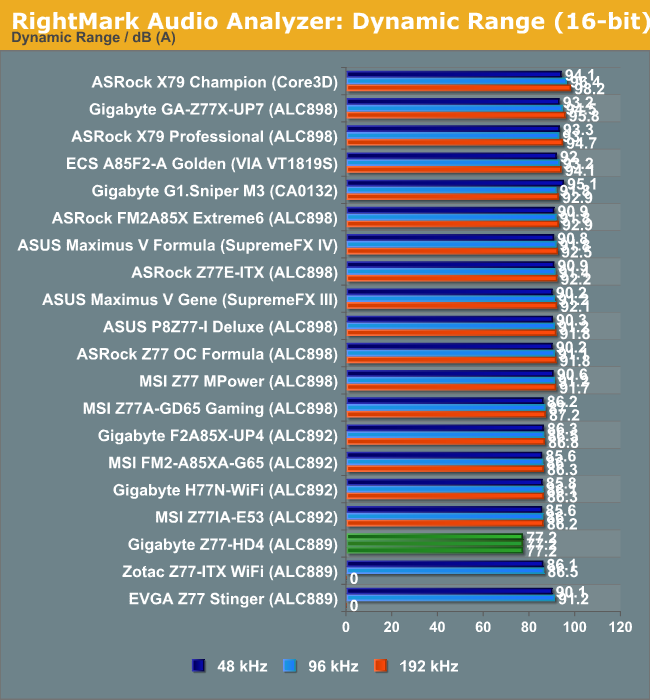
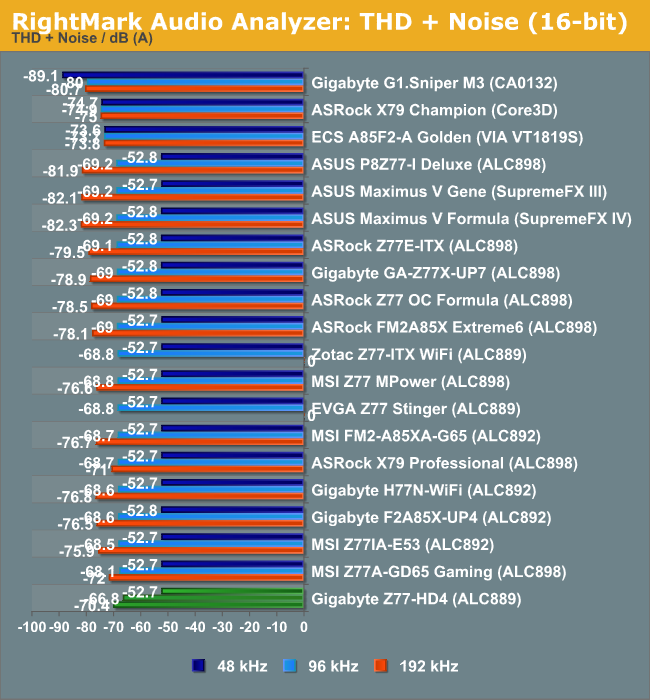
With the price of the board, we get one of the cheaper Realtek audio options. It performs worse in our testing than the ALC89x and above, but is able to pass our 192 kHz test unlike the ALC889 mITX versions.
USB 3.0 Backup
For this benchmark, we run CrystalDiskMark to determine the ideal sequential read and write speeds for the USB port using our 240 GB OCZ Vertex3 SSD with a SATA 6 Gbps to USB 3.0 converter. Then we transfer a set size of files from the SSD to the USB drive using DiskBench, which monitors the time taken to transfer. The files transferred are a 1.52 GB set of 2867 files across 320 folders – 95% of these files are small typical website files, and the rest (90% of the size) are the videos used in the WinRAR test.
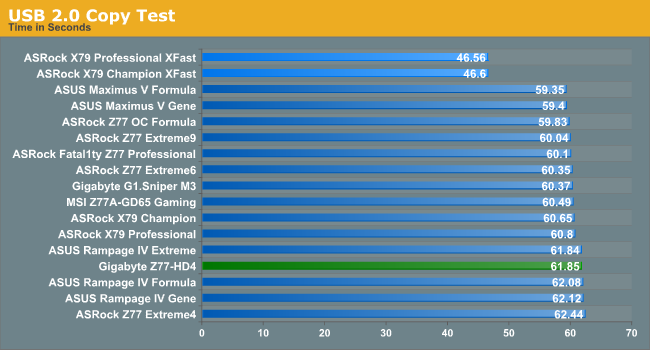
USB 2.0 performance is middling, on the wrong side of 61 seconds but only a fraction worse than the top non-XFast score.
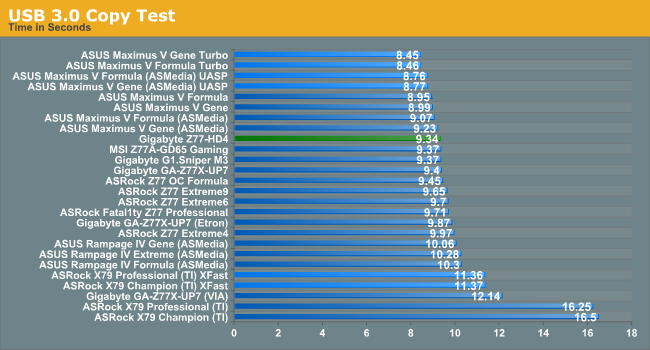
By contrast, the USB 3.0 performance is nearer the sharp end, despite sequential write speeds not being the best.
DPC Latency
Deferred Procedure Call latency is a way in which Windows handles interrupt servicing. In order to wait for a processor to acknowledge the request, the system will queue all interrupt requests by priority. Critical interrupts will be handled as soon as possible, whereas lesser priority requests, such as audio, will be further down the line. So if the audio device requires data, it will have to wait until the request is processed before the buffer is filled. If the device drivers of higher priority components in a system are poorly implemented, this can cause delays in request scheduling and process time, resulting in an empty audio buffer – this leads to characteristic audible pauses, pops and clicks. Having a bigger buffer and correctly implemented system drivers obviously helps in this regard. The DPC latency checker measures how much time is processing DPCs from driver invocation – the lower the value will result in better audio transfer at smaller buffer sizes. Results are measured in microseconds and taken as the peak latency while cycling through a series of short HD videos - under 500 microseconds usually gets the green light, but the lower the better.
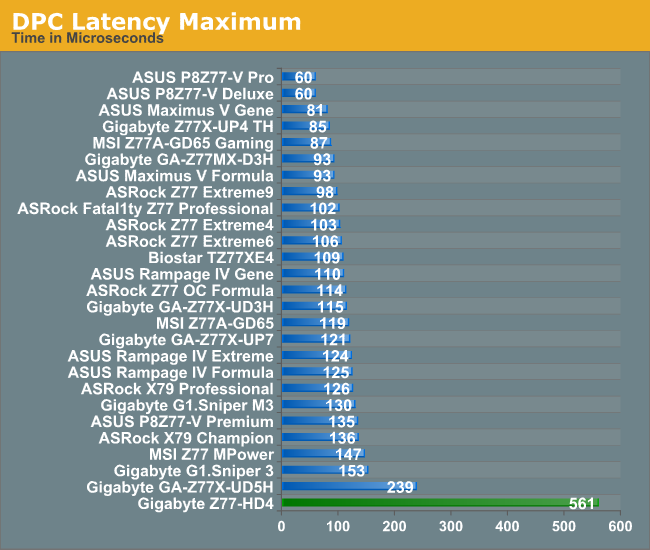
A major realisation of having that un-optimised BIOS is perhaps shown best in the DPC. To start, with the default install, the monitoring features of ET6 causes the DPC to peak at over 800 microseconds. Disabling this software causes a maximum of around 114 microseconds, although every so often we encountered a peak of around 300-500 microseconds, and 561 was recorded as the highest peak.










63 Comments
View All Comments
DanNeely - Monday, May 20, 2013 - link
Sata 6GB and USB3 both take significantly more die space on the chipset to implement; since most users only have at most a few devices that need the extra bandwidth most of ports offered on the chipset are still the older models. Haswell will probably be all Sata6GB on the chipset, although i wouldn't be surprised if some budget mobos add sata3gb ports via external controllers.The USB2/3 mix will probably last for a few more years on the desktop; this is both because of the much larger total number of ports involved, and because the internal headers aren't directly compatible (afaik you can buy adapters) and there're lots of cases which only have USB2 on the front panel; and lots of people with USB2 based cardreaders in a drive bay. I suspect one or two mobo headers for those will be with us for a long time; and wouldn't be surprised if a few linger as onboard/embedded device connects too like the pair of USB1 ports AMD chipsets still have (notionally for laptop keyboard/touchpad connects; but in both the desktop and mobile chipsets). I doubt the next generation of laptops will have any external USB2 ports; but might continue to use them internally.
maximumGPU - Monday, May 20, 2013 - link
haha those spam comments actually made me laugh.cjs150 - Monday, May 20, 2013 - link
This is a weird board.Full ATX but with 2x PCI slots. What do people use 1 for now, nevermind 2.
SATA sockets upright and in just the place that will ensure you lose the use of one of the SATA 6G sockets as soon as you put in a graphics card.
Spend a bit more a get a decent M-atx board with better layout
Wall Street - Monday, May 20, 2013 - link
Since the second x16 slot is powered from the x4 from the southbridge, I think they did this because they ran out of PCIe lanes. Also, some people use PCI for legacy devices. For example, I have a PCI TV tuner that I still use because a 4 year old tuner is just as good at HD as a new one.kasakka - Monday, May 20, 2013 - link
FireWire cards are actually still a good choice for using PCI slots, because most PCI-E FW cards cost 2x more and are essentially a PCI-to-PCI-E bridge chip + the PCI card's components. The few natively PCI-E FW cards are 3x more expensive than their PCI counterparts.Yes, FW still matters since most of the better audio interfaces use it so a big thing for studios or home recording, now that most motherboards don't come with a built-in FW chip.
It's the x4 full size PCI-E slots that make no sense to me.
DanNeely - Monday, May 20, 2013 - link
raid cards, or a second gpu for extra (non gaming) monitor outputs all need more than a single 1x lane; but 4 is plenty for anything they'd be asked to do. Some 4 port USB3 adapter cards on newegg are more than just 1x (though not explicitly marked I think they're 2x); presumably if you tried loading all 4 ports at once on the 1x cards you'd be bottlenecking on the PCIe bus.Wall Street - Monday, May 20, 2013 - link
You can install a PCIe x16 card in an x16 physical slot that is electrically PCIe x4. You also can install an PCIe x4 card in a x16 physical slot that is electrically x4. You cannot install a PCIe x16 card in a physical x4 slot. This is why they put an x16 physical slot for an x4 interface. An x16 physical slot is always at least as good.jabber - Monday, May 20, 2013 - link
X4 slots are hard to come by (I havent had a board with one fitted in years) so it may be they don't really make them anymore and just use a standard 16x slot instead.DanNeely - Monday, May 20, 2013 - link
I think the second PCI slot is as much about the limited number of PCIe lanes available as anything else. IIRC 7 series chipsets don't have native PCI support instead requiring a bridge chip, and only 8 PCIe lanes on the SB. That's 4 for the x4 slot, 2 for the 2x slots, 1 for the bridge, and 1 for the realtek nic (if I'm reading the specsheet right, the audio connects to the chipsets audio out and not over PCIe). That uses up all 8 available lanes; leaving the choice of only having 5 expansion slots filled, or spending more for a PCIe mux to add more available lanes. The latter is what I think many higher end boards do, but is cost-prohibitive in the value segment where every dollar counts.Cerb - Tuesday, May 21, 2013 - link
Awhile ago, I came across some audio books on cassette tape, and wanted to transfer them. My best input choice, by far, was an existing PCI sound card, with an external ADC. There you have it. For someone else, it may be an old but high quality plotter or scanner using SCSI, or a special serial card, or firewire card, or some other little thing.Like serial and parallel ports, PCI will be with us for awhile yet, though there is no good reason to need more than 1 of them, except that they would have had an unfilled slot, otherwise.
That 2nd slot is there, almost certainly, to fill space, due to using up the PCIe lanes available. Even MicroATX boards do this, giving 2 PCI slots, but an extra PCIe with more lanes, instead of several 1x PCIe slots.